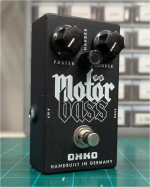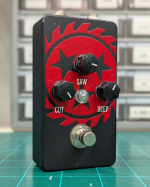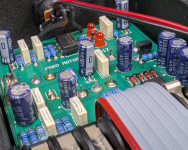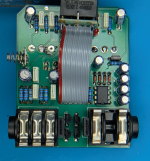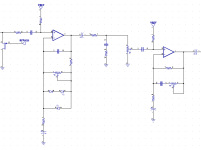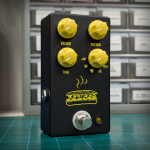You are using an out of date browser. It may not display this or other websites correctly.
You should upgrade or use an alternative browser.
You should upgrade or use an alternative browser.
What's on the workbench?
- Thread starter PedalPCB
- Start date
MichaelW
Well-known member
Probably printed on the board under the cap............
Robert
Reverse Engineer
I gotta give Jackson Audio credit for the design on the Prism, this is a really cool pedal, and I'm not even talking about how it sounds.
The whole thing is controlled by an Arduino nano... the relay switching, mode switching, gain level switch, etc.
The Gain toggle switch controls digital potentiometers which shift the gain levels for all three of the selectable gain stages.
The Mode toggle switch controls a series of relays to activate the appropriate gain stage. (BJT, MOSFET, or JFET)
The Boost pot is dual-gang, one gang is the actual analog gain control, the other gang sends a reference voltage back to the Arduino to change the color of the indicator LED as you turn the Boost up.
The star of the show though, to me, is the little LED diagnostic indicators like you'd see in high-end commercial / industrial electronics.
With a quick glance and no test equipment whatsoever, I can see that all three power supplies are up and running, the pedal is in bypass, the signal is not being muted by the opto, and I can see which mode is selected by the toggle switch.
This reminds me of my old days working at the repair shop.
Whoever designed this (Brad Jackson?) did a fantastic job, it's not every day something in a pedal impresses me this much. Good job Jackson, this is awesome. I honestly don't even care what the pedal sounds like at this point.
(Forgive the dust, this pedal has been sitting for three years)


The whole thing is controlled by an Arduino nano... the relay switching, mode switching, gain level switch, etc.
The Gain toggle switch controls digital potentiometers which shift the gain levels for all three of the selectable gain stages.
The Mode toggle switch controls a series of relays to activate the appropriate gain stage. (BJT, MOSFET, or JFET)
The Boost pot is dual-gang, one gang is the actual analog gain control, the other gang sends a reference voltage back to the Arduino to change the color of the indicator LED as you turn the Boost up.
The star of the show though, to me, is the little LED diagnostic indicators like you'd see in high-end commercial / industrial electronics.
With a quick glance and no test equipment whatsoever, I can see that all three power supplies are up and running, the pedal is in bypass, the signal is not being muted by the opto, and I can see which mode is selected by the toggle switch.
This reminds me of my old days working at the repair shop.
Whoever designed this (Brad Jackson?) did a fantastic job, it's not every day something in a pedal impresses me this much. Good job Jackson, this is awesome. I honestly don't even care what the pedal sounds like at this point.
(Forgive the dust, this pedal has been sitting for three years)
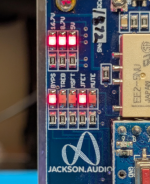

giovanni
Well-known member
Arduino project yay!!!I gotta give Jackson Audio credit for the design on the Prism, this is a really cool pedal, and I'm not even talking about how it sounds.
The whole thing is controlled by an Arduino nano... the relay switching, mode switching, gain level switch, etc.
The Gain toggle switch controls digital potentiometers which shift the gain levels for all three of the selectable gain stages.
The Mode toggle switch controls a series of relays to activate the appropriate gain stage. (BJT, MOSFET, or JFET)
The Boost pot is dual-gang, one gang is the actual analog gain control, the other gang sends a reference voltage back to the Arduino to change the color of the indicator LED as you turn the Boost up.
The star of the show though, to me, is the little LED diagnostic indicators like you'd see in high-end commercial / industrial electronics.
With a quick glance and no test equipment whatsoever, I can see that all three power supplies are up and running, the pedal is in bypass, the signal is not being muted by the opto, and I can see which mode is selected by the toggle switch.
This reminds me of my old days working at the repair shop.
Whoever designed this (Brad Jackson?) did a fantastic job, it's not every day something in a pedal impresses me this much. Good job Jackson, this is awesome. I honestly don't even care what the pedal sounds like at this point.
(Forgive the dust, this pedal has been sitting for three years)
View attachment 103135
View attachment 103136
ivandelado
Member
I have the Golden boy, would you like to trace it? I mean you can borrow it if you want :8I gotta give Jackson Audio credit for the design on the Prism, this is a really cool pedal, and I'm not even talking about how it sounds.
The whole thing is controlled by an Arduino nano... the relay switching, mode switching, gain level switch, etc.
The Gain toggle switch controls digital potentiometers which shift the gain levels for all three of the selectable gain stages.
The Mode toggle switch controls a series of relays to activate the appropriate gain stage. (BJT, MOSFET, or JFET)
The Boost pot is dual-gang, one gang is the actual analog gain control, the other gang sends a reference voltage back to the Arduino to change the color of the indicator LED as you turn the Boost up.
The star of the show though, to me, is the little LED diagnostic indicators like you'd see in high-end commercial / industrial electronics.
With a quick glance and no test equipment whatsoever, I can see that all three power supplies are up and running, the pedal is in bypass, the signal is not being muted by the opto, and I can see which mode is selected by the toggle switch.
This reminds me of my old days working at the repair shop.
Whoever designed this (Brad Jackson?) did a fantastic job, it's not every day something in a pedal impresses me this much. Good job Jackson, this is awesome. I honestly don't even care what the pedal sounds like at this point.
(Forgive the dust, this pedal has been sitting for three years)
View attachment 103135
View attachment 103136
jimilee
Well-known member
It’s practically an honor just to trace it.I gotta give Jackson Audio credit for the design on the Prism, this is a really cool pedal, and I'm not even talking about how it sounds.
The whole thing is controlled by an Arduino nano... the relay switching, mode switching, gain level switch, etc.
The Gain toggle switch controls digital potentiometers which shift the gain levels for all three of the selectable gain stages.
The Mode toggle switch controls a series of relays to activate the appropriate gain stage. (BJT, MOSFET, or JFET)
The Boost pot is dual-gang, one gang is the actual analog gain control, the other gang sends a reference voltage back to the Arduino to change the color of the indicator LED as you turn the Boost up.
The star of the show though, to me, is the little LED diagnostic indicators like you'd see in high-end commercial / industrial electronics.
With a quick glance and no test equipment whatsoever, I can see that all three power supplies are up and running, the pedal is in bypass, the signal is not being muted by the opto, and I can see which mode is selected by the toggle switch.
This reminds me of my old days working at the repair shop.
Whoever designed this (Brad Jackson?) did a fantastic job, it's not every day something in a pedal impresses me this much. Good job Jackson, this is awesome. I honestly don't even care what the pedal sounds like at this point.
(Forgive the dust, this pedal has been sitting for three years)
View attachment 103135
View attachment 103136
MichaelW
Well-known member
Hidden trannies under the ribbon cable? That's like to stop guys you cold yo....
Feral Feline
Well-known member
I gotta give Jackson Audio credit for the design on the Prism, this is a really cool pedal, and I'm not even talking about how it sounds.
The whole thing is controlled by an Arduino nano... the relay switching, mode switching, gain level switch, etc.
The Gain toggle switch controls digital potentiometers which shift the gain levels for all three of the selectable gain stages.
The Mode toggle switch controls a series of relays to activate the appropriate gain stage. (BJT, MOSFET, or JFET)
The Boost pot is dual-gang, one gang is the actual analog gain control, the other gang sends a reference voltage back to the Arduino to change the color of the indicator LED as you turn the Boost up.
The star of the show though, to me, is the little LED diagnostic indicators like you'd see in high-end commercial / industrial electronics.
With a quick glance and no test equipment whatsoever, I can see that all three power supplies are up and running, the pedal is in bypass, the signal is not being muted by the opto, and I can see which mode is selected by the toggle switch.
This reminds me of my old days working at the repair shop.
Whoever designed this (Brad Jackson?) did a fantastic job, it's not every day something in a pedal impresses me this much. Good job Jackson, this is awesome. I honestly don't even care what the pedal sounds like at this point.
(Forgive the dust, this pedal has been sitting for three years)
View attachment 103135
View attachment 103136
You could call this one "Action Jackson" ...
So, melting the tops of your capacitors is cool? If it is, just call me Miles Davis.
pricklyrobot
Well-known member
They also hand paint fake stripes on all the resistors. Some real artisanal shit!
CheapSuitG
The TubeSchemer
See when I started, I thought that was a bad thing melting the cap but apparently I was doing it right all along!
So, melting the tops of your capacitors is cool? If it is, just call me Miles Davis.
CheapSuitG
The TubeSchemer
You don't do paint resistors? Amateur.
Say I don't have any 4.7k I just grab my handy paint brush, slap on the right colors and BAM, that is what it will resist.
Say I don't have any 4.7k I just grab my handy paint brush, slap on the right colors and BAM, that is what it will resist.
They also hand paint fake stripes on all the resistors. Some real artisanal shit!
szukalski
Well-known member
This is where things should at in terms of innovation. I guess when you're powering an Arduino, then using non-latching relays doesn't make much difference to the power consumption!I gotta give Jackson Audio credit for the design on the Prism, this is a really cool pedal.
Gotta love the melted caps. It seems like an awful lot of extra effort when the inevitable is.. inevitable.
Brett
Well-known member
If only they'd have spent the same amount of effort on using the correct footprints for the electrolytic caps in the upper corners (edit: and middle) of the board...Well we're just full of surprises, aren't we?
karter3000
New member
Crunch Box with a charge pump/bipolar supply? That was my theory.
Robert
Reverse Engineer
Similar threads
- Replies
- 0
- Views
- 161
- Replies
- 2
- Views
- 335


